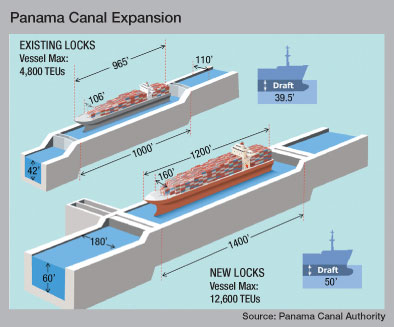 |
||||||||

Port Officials Hope History Repeats Itself
When it opened in 1914, the Panama Canal transformed global shipping. Rather than a 15,000-mile trip around South America to get from New York to California, the canal cut the journey by nearly two-thirds.
When the $5.25 billion Panama Canal expansion is complete in 2014, officials at the Port of Tampa and Port Manatee are hoping that it will help transform Tampa Bay from its traditional reliance on bulk cargo to more lucrative containerized shipments.
The Port of Tampa is in the midst of a $75 million container facility expansion that will increase its container yard from 25 acres to 160 acres. |
Still considered one of the Seven Wonders of the World even though it was built nearly 100 years ago, the Panama Canal will nearly double its capacity when the expansion is complete. Even more importantly from a shipping perspective, the new canal will be large enough to accommodate much larger ships.
The larger the ship, the more efficiently it operates. Panamax ships that ply the waters of the canal now are limited to about 4800 TEUs (20-foot-equivilant) containers. The Post-Panamax ships are nearly triple the size of the older vessels, carrying up to 12,000 TEUs, or about 6,000 tractor-trailers.
Currently nearly 70% of Asian cargo – including products from China, Japan and Malaysia – bound for the east coast is now off-loaded at west coast ports and moved across the country by truck or rail. With more efficient ocean service available, more than half of those shipments are likely to be diverted to ports on the eastern seaboard, predicts Richard Wainio, director of the Port of Tampa.
As the deep-water ports closest to the canal, the Port of Tampa and Port Manatee are both racing to complete new facilities to handle the anticipated increase in container shipments. The Port of Tampa is in the midst of a $75 million container facility expansion that will increase its container yard from 25 acres to 160 acres. At build-out, Tampa will be capable of handling 750,000 to 1 million TEUs.
 At Port Manatee, a new berth designed specifically for large container shipments is scheduled for completion in early 2010. An adjacent container yard, expected to be built in two phases beginning next year, will accommodate 500,000 TEUs when complete.
At Port Manatee, a new berth designed specifically for large container shipments is scheduled for completion in early 2010. An adjacent container yard, expected to be built in two phases beginning next year, will accommodate 500,000 TEUs when complete.
Even so, it’s highly unlikely that a Post-Panamax ship will ever call on a Tampa Bay port, says Steve Tyndal, senior director of trade development at Port Manatee. At 1200 feet long with a draft of 50 feet, they simply won’t fit in the shipping channel. Currently only about six US ports have channels and berths long and deep enough to accommodate the gargantuan ships.
What will probably happen is that the enormous ships will call upon a centrally located port, probably in the Caribbean, to offload their cargo onto smaller ships that more ports can handle, a hub-and-spoke strategy similar to that used by airlines with smaller planes feeding passengers to a larger city.
For ports competing for the new container business, the risks are high but the potential rewards are great, Tyndal said. “Containers provide more revenue to ports but they also require capital-intensive preparation.”
